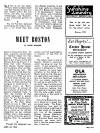
Home Page Meet Boston Menu Index
|
MEET BOSTON Friday, April 24, 1942 in What's New In Town W. J. Sidis |
As far as we can ascertain, street numbers reach into four figures on only sixteen streets within the city limits, and only two streets (Washington and Boylston) in the unannexed portion of Boston.
*
The old Puritans believed in storing up for times of scarcity―of which they had plenty in those early days. At least, a granary was provided on Tremont Street for that purpose. The cemetery next door is still known as the Old Granary Burying Ground. It is there that John Hancock, Paul Revere, Mother Goose, and numerous other old Boston worthies now rest. The Old Granary burned down before the American revolution. On its site, in 1806, was built the Park Street Church, as a refuge for old-time Puritans who saw all their old churches swinging to Unitarianism. It became known as “Brimstone Corner” on account of the virulence of the hell-fire sermons preached there. In 1831, the minister of that church composed a special hymn for his Fourth-of-July services. This hymn, introduced at the Park Street Church on [Monday] July 4, 1831, was the national song “America,” which for a full hundred years was a runner-up for official recognition as our national anthem, and is more expressive of the American spirit of freedom than its successful rival.
*
Though the telegraph was not a Boston invention (it was not even really an American one), still, Boston has its share in its development. Samuel F. B. Morse, who introduced this invention to America (popularly supposed to be the inventor), was a native of Charlestown, and lived there until shortly before his introducing the telegraph. Even the Postal Telegraph system was first organized by a collector of the Port of Boston.
*
The safety razor is one of Greater Boston’s inventions which has gone all over the world. It was originally invented in Brookline in 1903, and appears to have been somehow in the hands of a Boston bank by the time patent application was made. It was this Bostonian invention that was largely responsible for putting an end to the “fin de siecle” age of whiskers and mustaches. So important has this invention become that the statement has been made that the most widely distributed picture in the world is that of Gillette.
*
Part of the Boston city limits is based on a street that was never made. The Brighton-Brookline line east of Harvard Avenue is defined as 125 feet south of the southerly line of the proposed Holmes Avenue extension. Though Holmes Avenue is now Brainerd Road, and the extension was never built, that is how the present boundary is laid out.